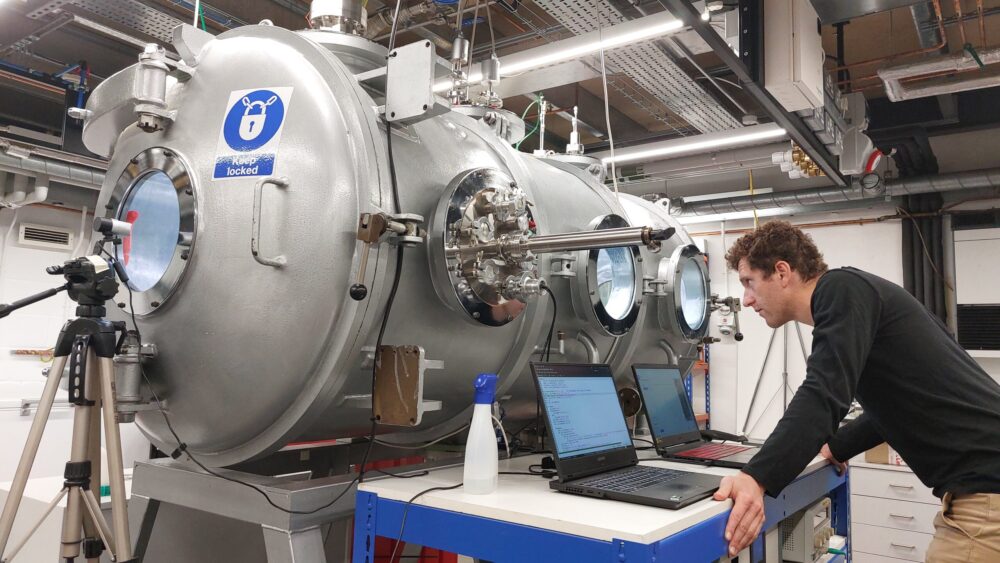OU News
News from The Open University
- Home
- Scientists simulate the Solar System’s ‘ice volcanoes’ in OU’s Milton Keynes lab
Scientists simulate the Solar System’s ‘ice volcanoes’ in OU’s Milton Keynes lab
Posted on • Science, maths, computing and technology

A team of international scientists, including researchers from the Atmospheric Research and Space Exploration group at The Open University (OU), have recreated the extreme conditions found on icy moons in deep space and revealed the unstable behaviour of water.
In the near-zero pressure environment of space, water reacts very differently from how it does on Earth. It simultaneously undergoes both boiling and freezing.
The icy moons are covered in an ice exterior with liquid oceans existing below the ice crust. Just as lava through volcanic activity reshapes the Earth’s surface, water reshapes icy moons through a process called cryovolcanism.
To understand how the altered behaviour of water might be driving geologic change on the icy moons, researchers from the OU, University of Sheffield and the Czech Academy of Sciences used a specially constructed low-pressure chamber at the OU in Milton Keynes to create the near-vacuum-like icy conditions found on Europa (a moon of Jupiter) and Enceladus (a moon of Saturn).
Both the icy moons have a frozen exterior. On Enceladus, the temperature at the equator is ‑193 degrees C. Astronomers have seen evidence of giant jets of water vapour and water particles being vented or ejected into space from a volcano-like process known as explosive cryovolcanism.
There is a similar process called effusive cryovolcanism, where liquid is released as a flow on the surface of the icy moons – akin to a lava flow found on Earth – although evidence for such activity is hard to detect.
The research team wanted to see if they could identify how effusive cryovolcanism happens by studying the behaviour of water in a near-vacuum environment. The findings have been published in the journal Earth and Planetary Sciences Letters.
They used a low-pressure chamber – ‘George’, the Large Dirty Mars Chamber – which is part of the world-leading Space and Planetary Environments Laboratory facilities at the OU. For the first time, scientists were able to run experiments exposing relatively large volumes of water to the vacuum of space, and observe what was happening.
As pressure inside the chamber was lowered, the water began to bubble and boil, despite being cold. Boiling created vapour which transported heat away from the water, and the water cooled, reaching its freezing point – and floating pieces of ice formed. They continued to grow in size, with new ice forming around their edges.
Within a few minutes, most of the water was covered by thin ice.
Below the ice covering, the liquid water continued to boil, with bubbles breaking through or deforming the ice layer, allowing water to effuse or escape through cracks onto the ice surface. Earlier studies involving much smaller volumes of water suggested thick ice would form and rapidly seal off the water to prevent further boiling.
On Earth, water follows well-known physical rules: it freezes below 0 °C and boils above 100 °C.
The researchers hope their investigation will help identify ancient signs of cryovolcanic activity not only on icy moons but across other celestial bodies in the Solar System.
The process the scientists observed of bubbles rising up and deforming the ice cap resulted in an uneven ice crust with bumps and depressions.
Manish Patel, Professor of Planetary Science at the Open University, co-author and academic lead for Atmospheric research and Space exploration group, said:
“These topographic irregularities – caused by trapped vapour beneath the ice – may leave distinct signatures that could be detectable by orbiting spacecraft, for example by those equipped with radars, offering a potential new way to identify ancient cryovolcanic activity.
“This could provide valuable clues for planning future missions to these remote worlds—and help us better understand the still mysterious process of cryovolcanism.”
The research was funded by the Czech Science Foundation and the UK Space Agency. The paper can be downloaded here.